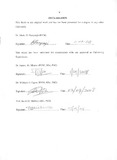| dc.description.abstract | Ticks resistance to acaricides is an increasing problem in Kenya and other parts of the world. It poses an economic burden due to livestock losses and enormous costs of developing novel acaricides. Traditional healers in Samburu district have utilised herbs for management of tick infestation despite the lack of scientific evidence of efficacy. The objectives of this study were to develop an inventory guide for Samburu plant use and scientifically validate the pharmacological and toxicological activity of two preferentially used herbal acaricides.
A sensitization workshop was held in February 2007 involving the University research team, local leaders and 15 herbalists at Nomotio Livestock and Improvement Center in Maralal. Indigenous knowledge, intellectual property rights on bioprospection, plant conservation and integration of ethnopractises in mainstream disease mitigation were deliberated on. Data on plant use and voucher specimens were collected using Participatory Rural Approaches from 15th to 19th of May 2007 in which 70 informants including pastoralists, healers, housewives and opinion leaders participated. Oral interviews and pretested semi-structured questionnaires were admitted for qualitative data gathering.
Using standard botanical procedures Acokanthera schimperi (Lmorijoi) and Psiadia punctulata (Labaai) were selected out of the sixty two (62) plants documented since they were ranked highly by the locals in management of ticks. Voucher specimens of all the plants were deposited at East African Herbarium and Botany department, University of Nairobi for confirmatory identification.
In-vitro bioassays were conducted at the International Livestock Research Institute Laboratories to determine the plants potential acaricidal activity. The plant specimens were dried, pulverised, methanol extracted then lyophilized and homogenized. Twelve (12) grams of fine powder of each plant was used to prepare a stock solution of 5000 ppm of both extracts was formulated and lower concentrations of 4000 to 1000 ppm prepared by serial dilution in deionised water 24 hours prior to the bioactivity tests.
Thirty (30) unfed 14 day old larvae of Rhipicephalus appendiculatus and Boophilus decolaratus were enclosed in filter paper packets impregnated with 2ml of each extract at stated concentrations and controls in triplicate. They were incubated at 27-28°C and 90-95% RH for 24 hours at 12:12 hour photoperiod (Light: Day). A. schimperi at 5000 ppm produced 63% and 53% mortality to B. decoloratus and R. appendiculatus respectively. Psiadia punctulata at 5000 ppm produced 90% and 60% mortality to larvae of B. decoloratus and to R. appendiculatus respectively. Probit analysis and linear regression modelling at (p<0.05) was calculated by interpolation of mortality counts to establish lethal concentrations (LC). A. schimperi produced larvicidal activity with LC50/LC99 values of 4509/10611 ppm and 2787/8945 ppm, while P. punctulata had LC50/LC99 values of 3918/10020 ppm and 1857/8347 ppm on R. appendiculatus and B. decoloratus, respectively. Data on plant use from the informants yielded 990 citations on 62 medicinal plants used to treat animal and human diseases
The documented use of these plants is promising for search of alternative acaricides. Further pharmacological, toxicological and phytochemical cross-screening to develop effective and cheaper pharmaceuticals of medical and veterinary importance | en_US |



